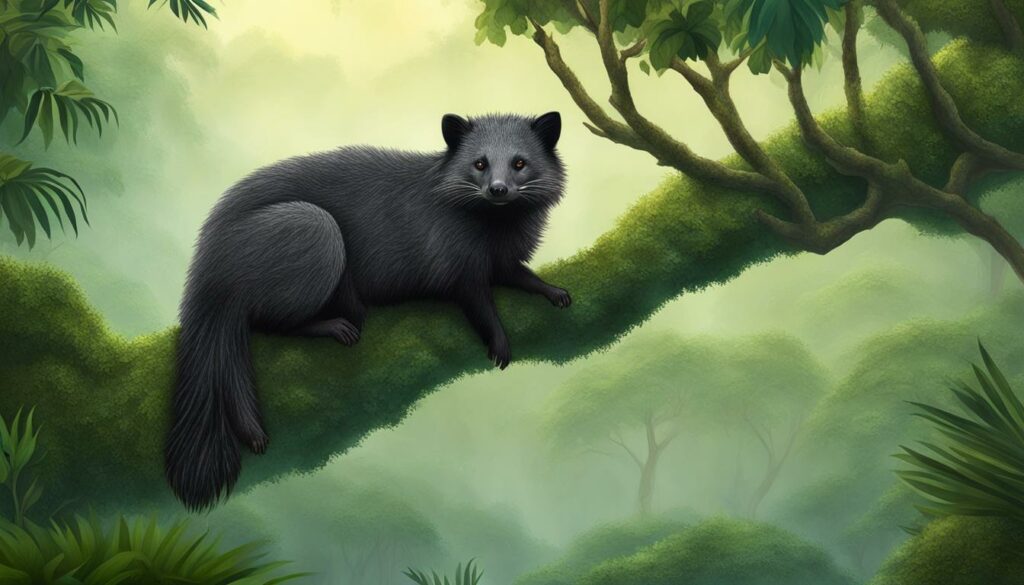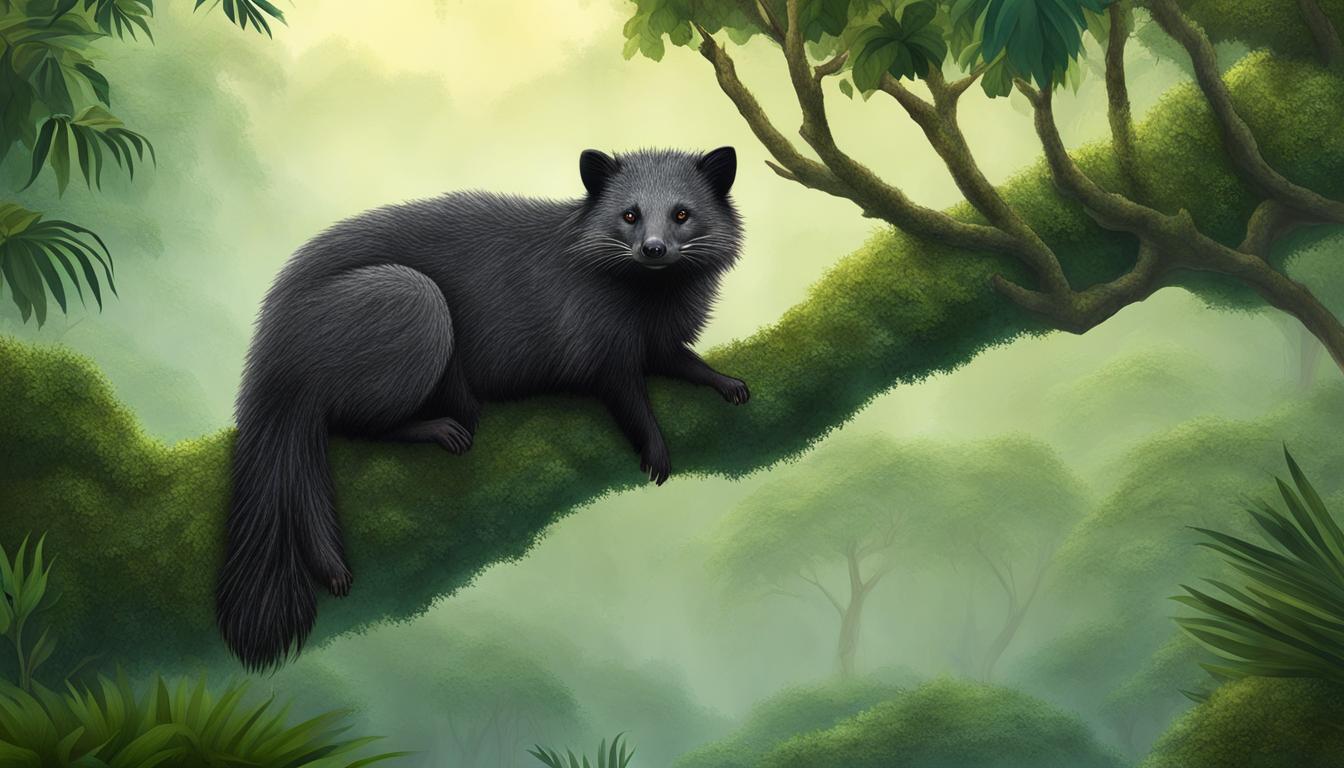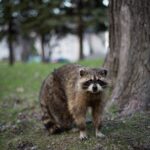Welcome to our exciting exploration of the fascinating world of the binturong! In this article, we will delve into the incredible diversity of the binturong’s family and uncover its closest relative. Get ready to uncover the secrets of the binturong’s relatives and discover the amazing species that share its lineage.
Before we reveal the binturong’s closest relative, let’s take a moment to appreciate the binturong itself. Also known as the bearcat, the binturong is a captivating creature that belongs to the Viverridae family. This family encompasses a wide range of animals, including civets and genets.
The binturong possesses a unique appearance, with its long, low, stocky body covered in coarse black fur tipped in gray. Its face resembles that of a cat, while its body resembles a small bear, and its tail bears a resemblance to that of a monkey. Truly a remarkable creature!
Native to the lush tropical rainforests of South and Southeast Asia, the binturong thrives in its natural habitat. Its closest relative is equally intriguing, and we are about to embark on a journey to discover this fascinating species. Join us as we unravel the mystery and unveil the binturong’s family tree!
Taxonomy and Classification of the Binturong
The binturong, scientifically known as Arctictis binturong, belongs to the Carnivora order, Feliformia suborder, Viverridae family, and Paradoxurinae subfamily. It is the only species in the genus Arctictis. As an important part of the animal kingdom, the binturong shares its evolutionary and genetic relatives with other members of the Viverridae family, such as civets and genets.
The classification of the binturong provides valuable insights into its genetic lineage and relationship with other species. By understanding its taxonomy, scientists gain a better understanding of the binturong’s place in the natural world. The binturong’s evolutionary relatives within the Viverridae family share common traits and characteristics, contributing to a deeper understanding of their shared genetic heritage.
To illustrate the binturong’s taxonomy and classification, the following table presents a summary of its categorization:
| Order | Suborder | Family | Subfamily | Genus | Species |
|---|---|---|---|---|---|
| Carnivora | Feliformia | Viverridae | Paradoxurinae | Arctictis | binturong |
By examining the binturong’s taxonomy and classification, researchers gain a comprehensive understanding of its genetic and evolutionary relationships within the Viverridae family. This knowledge deepens our appreciation for the unique characteristics and adaptations that make the binturong such a fascinating creature.
Characteristics and Physical Features of the Binturong
The binturong, also known as the bearcat, has several distinctive physical features that set it apart from other animals. Its long and heavy body is supported by short, stout legs, which allow it to navigate through the dense vegetation of its habitat. The binturong is covered in coarse black hair, often streaked with silver, giving it a unique appearance.
One of the most remarkable characteristics of the binturong is its bushy and prehensile tail. This tail is not only used for balance but also for grasping branches, allowing the binturong to move with ease in the treetops. Its muzzle is short and pointed, adorned with bristly brown hairs, and it has large black eyes and short rounded ears with tufts of black hair.
The feet of the binturong are five-toed, equipped with large strong claws that enable it to climb and grip tree trunks effortlessly. These physical features make the binturong an expert climber and adept at moving through the trees. When it comes to physical characteristics, the binturong is most closely related to other members of the Viverridae family, such as civets and genets.
Table: A Comparison of Physical Features
| Feature | Binturong | Civet | Genet |
|---|---|---|---|
| Body shape | Long and heavy | Slender and agile | Slender and agile |
| Tail | Bushy and prehensile | Short and non-prehensile | Long and non-prehensile |
| Coat color | Coarse black hair with silver streaks | Varies, often spotted or striped | Varies, often spotted or striped |
| Ears | Short and rounded with tufts of black hair | Short and rounded | Pointed and rounded |
| Claws | Large and strong | Short and sharp | Short and sharp |
Habitat and Diet of the Binturong
The binturong is well-adapted to its natural habitat, the tropical rainforests of South and Southeast Asia. These lush forests provide the perfect environment for the binturong’s arboreal lifestyle. They prefer tall, healthy forests with dense tree cover, as it offers them ample opportunities for climbing and foraging.
Being primarily arboreal, binturongs spend most of their time in the canopy, using their prehensile tail to grip branches and navigate tree trunks with ease. This unique adaptation allows them to move effortlessly through the dense vegetation. Their strong claws and agile movements make them excellent climbers, enabling them to reach food sources that other animals may struggle to access.
When it comes to their diet, binturongs are omnivorous, meaning they consume both plant matter and animal prey. They have a varied diet that includes small mammals, birds, fish, worms, insects, plant shoots, leaves, and fruits. This versatility in their diet is advantageous, as it allows them to adapt to the seasonal availability of food in their habitat.
Binturong’s Diet
| Prey | Plant Matter |
|---|---|
| Small mammals (e.g., rodents) | Plant shoots |
| Birds | Leaves |
| Fish | Fruits |
| Worms | |
| Insects |
Binturongs also play an important role in seed dispersal, particularly for fruits like the strangler fig. As they consume fruits and move through the forest, they inadvertently spread the seeds of these plants, aiding in their reproduction and contributing to the overall biodiversity of the ecosystem.
In summary, the binturong thrives in the tropical rainforests of South and Southeast Asia, utilizing its arboreal adaptations to navigate its habitat with ease. Their omnivorous diet ensures their survival by allowing them to take advantage of various food sources, while also contributing to the dispersal of seeds and the maintenance of the forest ecosystem.

Reproduction and Behavior of the Binturong
Not much is known about the reproduction of binturongs, as they are elusive creatures that live high up in the treetops of tropical rainforests. It is believed that mating can occur throughout the year, with the embryo’s implantation being delayed until favorable environmental conditions in January, February, or March. This delayed implantation allows binturongs to time their births with optimal food availability and other favorable conditions.
Binturongs are known for their varied vocalizations, which they use for communication. They can emit grunts, wails, hissing sounds, and purring. These vocalizations serve to establish territories, attract mates, and communicate with other binturongs in their vicinity. Their distinctive and diverse vocal repertoire helps them navigate their environment and maintain social bonds.
Binturongs are primarily nocturnal and crepuscular, meaning they are most active during the early morning and late evening. This activity pattern allows them to avoid the intense heat of the day while taking advantage of the dim light conditions to hunt for food. They are solitary animals and are known to be territorial, marking their territories with scent markings and vocalizations.
Behavior Table
| Behavior | Description |
|---|---|
| Vocalizations | Binturongs communicate through grunts, wails, hissing sounds, and purring. They use vocalizations to establish territories, attract mates, and communicate with other binturongs. |
| Activity Pattern | Binturongs are primarily nocturnal and crepuscular, with peaks of activity in the early morning and late evening. |
| Territorial Behavior | Binturongs are solitary animals and mark their territories with scent markings and vocalizations. |
Threats to the Binturong’s Survival
The binturong, also known as the bearcat, faces numerous threats to its survival. One of the main challenges is habitat loss and degradation. The tropical rainforests of South and Southeast Asia, which are the binturong’s natural habitat, are being destroyed due to logging and agriculture. Deforestation not only removes the trees that the binturongs rely on for shelter and food but also disrupts their overall ecosystem.
Another significant threat to the binturong is the illegal pet and traditional medicine trade. Binturongs are sometimes captured and sold, leading to a decline in their population. They are also hunted for their meat and fur, further exacerbating the threats they face. These activities, combined with habitat destruction, have resulted in the binturong being classified as vulnerable on the IUCN Red List.
To protect the binturong and ensure its survival, conservation efforts are crucial. Implementing measures to combat deforestation and promote sustainable land use practices is essential. Additionally, raising awareness about the importance of protecting this unique species and enforcing laws against the illegal trade in binturongs can help address the threats they face. Collaborative efforts between governments, conservation organizations, and local communities are vital in safeguarding the binturong’s future.

| Threats to the Binturong’s Survival | Impact |
|---|---|
| Habitat loss and degradation | Removal of shelter and food sources, disruption of the ecosystem |
| Illegal pet and traditional medicine trade | Decline in population, exploitation of binturongs for commercial purposes |
| Hunting for meat and fur | Further decline in population, loss of individuals due to human activities |
Conclusion
The binturong, also known as the bearcat, is the closest relative to the binturong. It belongs to the Viverridae family, which includes other animals such as civets and genets. This family of closely related species shares common characteristics and adaptations that allow them to thrive in their respective habitats.
The binturong, with its long and low stocky body covered in coarse black fur tipped in gray, has a unique combination of features that make it stand out. Its face resembles a cat, its body resembles a small bear, and its tail resembles that of a monkey. These distinctive physical features are shared with other members of the Viverridae family, highlighting their kinship.
While the binturong and its relatives have adapted well to the tropical rainforests of South and Southeast Asia, they face numerous threats to their survival. Habitat loss, degradation, and fragmentation caused by human activities such as logging and agriculture pose significant challenges. Additionally, the binturong is at risk of being captured for the pet and traditional medicine trade, as well as hunted for its meat and fur.
Given the declining population and the destruction of their natural habitats, the conservation of the binturong and its relatives is crucial. Efforts should be made to protect and preserve these unique species and their families. By raising awareness about their importance and implementing effective conservation measures, we can ensure a sustainable future for the binturong and other related species in their natural habitats.
FAQ
What is the closest relative to the binturong?
The closest relative to the binturong is the bearcat, also known as the binturong.
What family does the binturong belong to?
The binturong belongs to the Viverridae family, which includes other animals such as civets and genets.
What is the taxonomy of the binturong?
The binturong belongs to the species Arctictis binturong in the genus Arctictis. It is classified under the Carnivora order, Feliformia suborder, Viverridae family, and Paradoxurinae subfamily. It is the only species in the genus Arctictis.
What are the physical characteristics of the binturong?
The binturong has a long, low, stocky body covered with coarse black fur tipped in gray. It has a face like a cat, a body like a small bear, and a tail like a monkey.
Where are binturongs native to?
Binturongs are native to the tropical rainforests of South and Southeast Asia.
What is the diet of the binturong?
The binturong has a varied diet, which includes small mammals, birds, fish, worms, insects, plant shoots, leaves, and fruits. They are omnivores and play an important role in seed dispersal.
Are binturongs social animals?
No, binturongs are solitary animals and are known to be territorial.
Why is the binturong classified as vulnerable?
The binturong is classified as vulnerable on the IUCN Red List due to a declining population. The main threats to their survival include habitat loss, degradation, and fragmentation, as well as the pet and traditional medicine trade.





